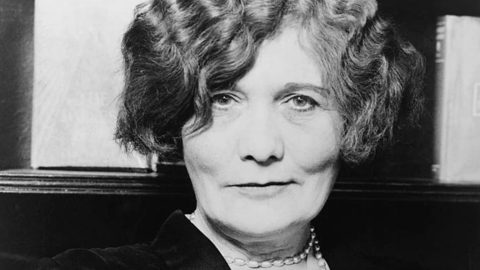The most dangerous woman in the world

It takes a lot to be branded “The Most Dangerous Woman in the World.” You need to live a life that’s more skeletons than closet. You keep your head on a swivel, trying to stay a step ahead of the people in hot pursuit—the press, the cops, your victims. This was life for Mary Ann Duignan, a.k.a. May Churchill Sharpe, a.k.a. “Chicago May,” who made her way from Europe to America and back again as one the most notorious criminals of the early 1900s. As historian Laurence William White writes, “by allying prostitution with robbery and blackmail, [Chicago May] was soon a familiar figure among the gamblers, gangsters and courtesans.”
Duignan was born in Ireland in 1871. But life across the ocean was calling her, and she answered by leaving home in 1890. This wasn’t an unusual decision, explains Lauren Byrne in her review of Nuala O’Faolain’s biography of Duignan. Half the population of post-famine Ireland was emigrating, but Duignan did things a little differently.
“May left home in the middle of the night, taking her family’s life savings with her,” Byrne notes. And unlike other European emigrants, Duignan made that transatlantic trip in luxury, using her stolen gains to travel first-class. “She relished the social havoc she caused,” writes Byrne, “a peasant among the gentry.”
After a stop in New York, Duignan made her way to Nebraska, where she met and married Dal Churchill, “the first of her several short-lived marriages,” Byrne explains. When Mr. Churchill was killed, she moved to Chicago, assuming the sobriquet “Chicago May.”
The city was buzzing with the excitement of the 1893 World’s Fair. Even though the exhibition promised to bring new jobs and vitality to an area that was experiencing massive unemployment and homelessness, it wasn’t a promise it could keep. As Byrne writes, “When one hundred jobs were advertised for women at the world’s fair, 10,000 applicants responded.” There was simply more need than opportunity. And May, like many women in the city, turned to sex work to make ends meet. Though she did often have sex with clients, she also had another hustle.
“She preferred to call herself a ‘badger,’” Byrne explains, “a con-woman who entices her victim with sex, then robs him before she has to complete her part of the bargain.”
But no matter how good of a criminal you are, you need to know when to leave the scene.
She later returned to New York where she made her living both continuing her “badgering” and as a chorus girl. There aren’t many references to how good she was on the chorus line, but her badgering skills kept growing, plus she added blackmail to her repertoire. As White writes, “using compromising letters or photographs; victims made substantial and repeated payments to avoid exposure or the threatened wrath of her fictitious ‘enraged husband.’” She managed to work her con in both North and South America.
These cons enabled her to live a life of luxury, with one newspaper describing her as a girl whose “diamond rings were as big as hickory nuts.” She charmed or bribed her way through the city for years. But no matter how good of a criminal you are, you need to know when to leave the scene. And Chicago May knew her time was up, fleeing to Europe when the cops got too close.
In London she met Eddie Guerin; they robbed an American Express office in Paris together. Though she managed to get to London before being arrested, she “loyally, if stupidly” returned to France, “and for her trouble she received five years in Montpelier [sic] prison,” Byrne writes.
But she didn’t stay incarcerated for long. As White explains, May “seduced and blackmailed the prison doctor into signing a medical certificate for her release” halfway through her sentence. She found herself back in court after an attempt on Guerin’s life, resulting in another stint in prison.
Though May eventually went back to America, it wasn’t the glamorous life she’d known. As White writes, “in poor health and suffering from alcoholism, she experienced indifferent success and frequent scrapes with the law.” She died in 1929 following complications from surgery.
It’s easy to look at her as a dangerous, uncaring woman—she even wrote that “crime never occurred to me as being a sin”—but there’s much of her life that speaks to the times.
“The options for a peasant woman in nineteenth-century Ireland were marriage or emigration,” Byrne writes. “The grinding monotony of household drudgery was hardly an attractive proposition to someone who had sailed across the Atlantic in first-class splendor.”
May’s life and motivations might always be a mystery. As Byrne muses, “can we ever understand the past, or do we just endlessly rework it to suit us in the present?”
This article appeared on JSTOR Daily, where news meets its scholarly match.





